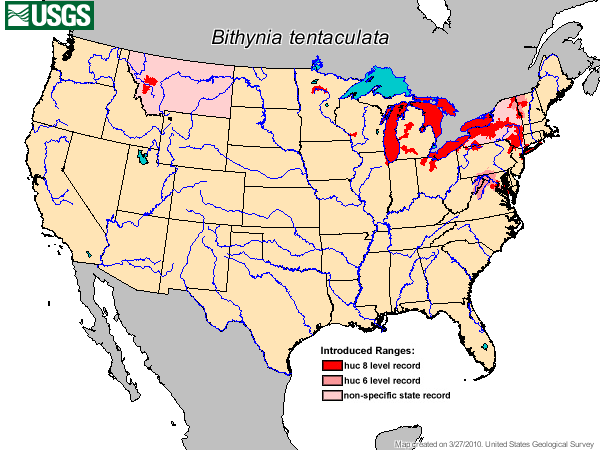
Habitat
The faucet snail is native to and distributed throughout Europe (from Scandinavia to Greece), and was introduced into the Great Lakes in the early 1870's (Kipp and Benson, 2010). Since its introduction it can often be found in the shallow lakes and ponds often near the upper part of the Mississippi River, one such area being Lake Onalaska. The plethora of faucet snails in Lake Onalaska has been studied due to some interesting interactions with the faucet snail, waterbirds and trematodes (for more information on this interaction click here).
 Photo courtesy of the
U.S. Geological
Survey
Photo courtesy of the
U.S. Geological
Survey
In the shallow lakes and ponds where it resides this snail can be found on the underside of rocks and other substrates, as well as on aquatic macrophytes (milfoil (Myriophyllum spicatum and muskgrass, Chara spp.) in the warmer months (Kipp and Benson, 2010). And, found at the bottom of water beds during winter, where water temperature does not go below 4°C during an average winter (Wächtler 2001). B. tentaculata will not be found in fast running water, since the high velocity will make it impossible for the snail to adhere to suitable substrates or macrophytes (Wächtler 2001). As a result the snail is not found in the river bed (except winter) but most often on vegetation or the underside of stones near the river banks (Wächtler 2001).
Even though B. tentaculata does not reside in fast moving water, it still demands a habitat with sufficient oxygen availability. Since the faucet snail respires by means of its ctenidium (their comb-like gills), sufficiently aerated water is needed (Wächtler 2001). Sufficient oxygen is also needed for the habitat the embryo is developing in and so females are pressured to find well oxygenated areas (Wächtler 2001). An oxygen lacking area causes slow development of the embryo and therefore longer hatch time which is not beneficial to spawns that are only able to resist desiccation for a few hours before severe damage (Wächtler 2001). As adults, faucet snails are able to resist desiccation in dry mud for more than a month (Wächtler 2001).
 Although B. tentaculata is able to temporarily
resist desiccation; draught or flood, prolonged ice cover,
reductions in macrophytes, food shortage, pollution, fungicides and
chemicals are known to affect the life histories of gastropods (Wächtler
2001). Even though many things could potentially harm the faucet snail,
it mainly chooses a habitat based on the
presence of appropriate food sources (Wächtler 2001).
Although B. tentaculata is able to temporarily
resist desiccation; draught or flood, prolonged ice cover,
reductions in macrophytes, food shortage, pollution, fungicides and
chemicals are known to affect the life histories of gastropods (Wächtler
2001). Even though many things could potentially harm the faucet snail,
it mainly chooses a habitat based on the
presence of appropriate food sources (Wächtler 2001).
Return to the Home page